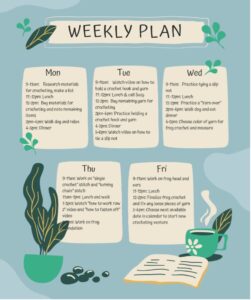By Jessica Bauman
In April, my husband and I became first-time homeowners, and in May, we moved into our new house. We’re already quite experienced with moving, so the executive functioning demands of packing, moving, unpacking, and settling in were pretty routine. Additionally, many of our friends bought houses before we did, so we were used to the idea that homeownership comes with seemingly never-ending projects. If you’re a new or even a seasoned homeowner, the topic of this blog is no doubt a familiar one, and I hope you find both some new ideas to make home maintenance more organized and efficient, and reassurance that you’re not alone! If you are yet to become a homeowner, I hope you’ll learn some helpful ideas for your future self and that you can share them with friends and family who might find them helpful.
Challenges
Time management
- Scheduling routine maintenance: Regular check-ups and services for HVAC, plumbing, landscaping, and more. We haven’t lived here long enough to have this high on our radar, but we’re planning for it.
- Managing long-term projects: Renovations, upgrades, improvements, etc. My personal experience so far is that the backyard suffered from decades of neglect. There’s a steep hill that needs stairs and erosion management, and the plant life is currently exclusively invasive vegetation. This is going to be FUN, and it’s going to be a BIG project!
Problem-solving
- Unexpected repairs: I think we can revise the old saying about death and taxes being the two certainties in life and add a third: unexpected repairs in your house. Before we moved in, we realized the house wasn’t wired for internet! And within a week of moving in, the main bathroom showerhead fell off of the wall!
Attention to Detail
- Record-keeping: Keeping records of repairs, improvements, and finances. As with scheduling routine maintenance, we’re in the early stages of this, but planning has begun.
- Budgeting: Planning for expenses in the context of the overall household budget; seeking cost-effective contractors for maintenance, repairs, and upgrades; and selecting energy-efficient options. We’ve encountered wildly varying prices from equally well-regarded landscaping contractors for solving our backyard issues.
Solutions
- Create a home management folder/binder: Have one place where important documents live. Important papers include those produced by others such as warranties, receipts, and manuals, but also include those that you produce, such as:
- a budgeting spreadsheet
- a dedicated calendar to track and plan routine maintenance
- contact information for trusted professionals
This can be either paper or digital, depending on your preference. We use digital for portability and ease of collaboration.
- Use technology to work smarter, not harder: One app I’m so grateful to have randomly stumbled upon is Thumbtack. This app lets you easily communicate simultaneously with multiple professionals about routine and unexpected work you need done at your property, allowing you to compare reviews, costs, availability, and other important considerations. Furthermore, it automatically generates a suggested schedule of routine maintenance tasks that can be easy to forget, such as inspecting the attic, flushing the gutters, clearing the dryer vent, and more!
- Seek support: Knowing your neighbors is a good thing! Connecting with your community through e-mail listservs, social media platforms, and in-person events allows you to get valuable information on how to handle processes and find trusted service providers. We recently learned that our neighbors’ yard was in a similar state to ours when they moved in – before we were born! It is GORGEOUS now, and I’m sure it has been for a long time. We look forward to continued socializing to pick their brains about their experience. Your network that doesn’t live right near you can be helpful as well, as many professionals serve a broad area. In addition to loving my work at Thinking Organized, I’m grateful to a colleague there for connecting me to an excellent exterminator company for the carpenter ants in the yard that are too close for comfort to the house!
Owning a house comes with all sorts of challenges, but by planning ahead, I know that this will be the home of our dreams.
 THINKING ORGANIZED
THINKING ORGANIZED
